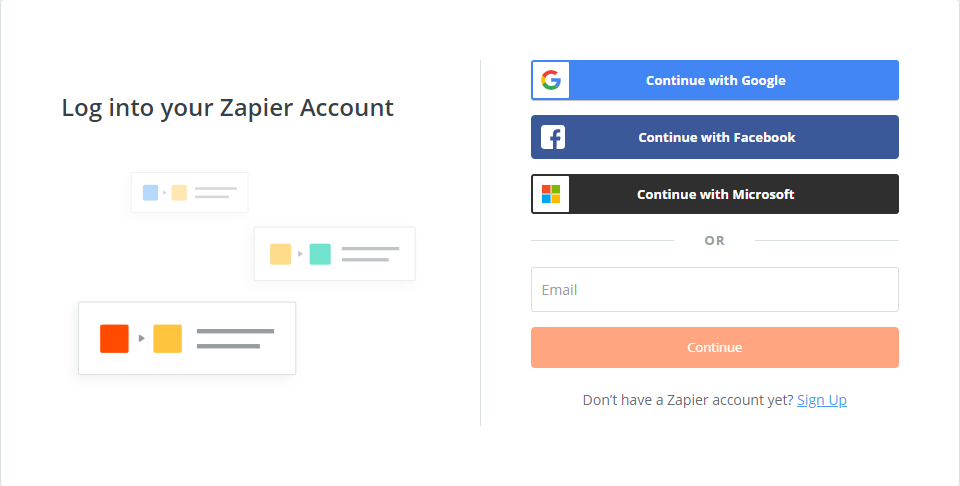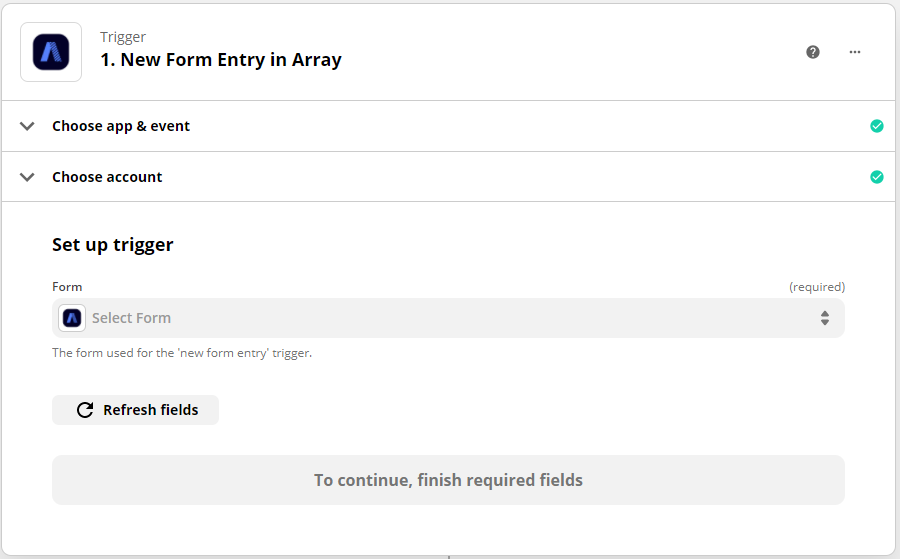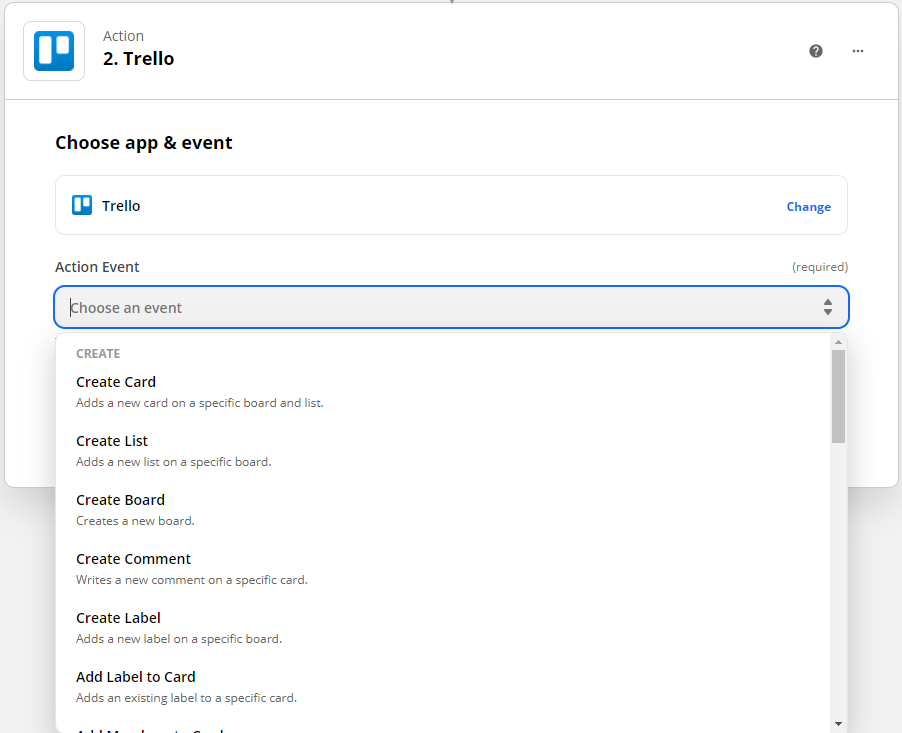Zapier Integration with MailChimp
A healthy, engaged email mailing list is a marketer’s favourite asset. It provides a direct line of communication with a body of customers who’ve already expressed a willingness to learn more about your brand or product. They want to hear what you have to say.
Array’s MailChimp integration helps grow your list. Kill two birds with one stone by sending a form responder’s information to your MailChimp list — just be sure to let them know your plans, of course!
In this article, we'll be showing you how to:
- Connect your Array account to MailChimp
- Place fields on a form that will add new subscribers to an email mailing list
- Create a new MailChimp mailing list from within Array
How to set up Zapier
If you would like to get started using Zapier, click the link here to locate to Array/Zapier setup.
You will need to ensure you have a Zapier account set up. Visit Zapier's login page to set up your account

If you have an existing account then login with your details.
Once you have created an account the integration is set up and you can begin to set up your Zaps in Zapier.
Setting up a Trigger
First, start by signing into your Zapier account.
Either navigate to the admin dashboard of your account on the left hand side menu and click on 'Zaps'

Or select the large 'Make a Zap' button to begin.

You will be taken to a page where it will show you all applications you have linked to your account.
This is where we begin. Zapier will walk you through each step so you can set up your zaps correctly.
If Array is not linked to your Zapier account begin by searching for Array and adding your account. This is what Zapier call a 'Trigger App' to start the process.

You are then directed to choose a trigger that will cause your new Zap to happen. This could be when a form is submitted or if you want the process to occur after administration of your submission, you may want to start the Zap when a form is updated.

For this example, we have selected 'New Form Entry'

Now you will need to sign in to your Array account by clicking on 'Sign in to Array'

A pop up window will appear to put your log in details in.

Now select the form that you would like the action to happen upon. You can either search for the form or look at the drop-down that is produced.

If your form is not shown, select the 'Load More' button to load more.

If this does not work, you can use the advanced feature to locate your form with the Unique ID produced at the end of the form URL. To understand this more follow the doc here.

You need to ensure at least one submission of the form has been completed on Array for Zapier to pick up and test the form itself.

Once this has been successful you will move onto the application you want to connect with in exactly the same manner, expect you will be choosing what you want to happen to that submission/data on that form. This is called the 'Action'.
Setting up an Action
Firstly, Select your Action Application. If you have not already linked any to your account this is where you will be asked to do so. You will be provided with a long list of apps to choose from as well as built-in software you may already use. Either search for the application in the search bar or scroll the page to see what apps are available.

In this example, I shall choose Trello.
Next stages you are asked what you want the action to be. You will see on Trello you have a few options but this could range from anything to set up a calendar event with the specific date on the form to sending specific data on the form to Asana or another CRM. There are hundreds of actions and depending on the app/software will depend on the Zaps that can be performed.
Here for Trello I have the option to Create a new List/Board/Card and more or search for Find Board/Find Member/Find Card and more. Depending on your action will depend which one you choose. each has a description so can be understood easily.

Once you have chosen your action to perform you will be asked to link your account so Zapier has access to send the data to. This will run a quick test to ensure it has access and you can continue.

Once linked you will be asked to select what/where you want that data to go. There will be a number of options here and some will be mandatory and others will not depend if you want that information to be passed over. Each Zap will have its own criteria here.

You will then again be asked to confirm the steps in tis action and complete a test which will send a test to your desired location just like it was an action.
Once completed, Click finish, Ensure your Zap has a name and you will be all good to go. Just sit back, relax and watch the magic happen with all those submissions!

Once you have a few Zaps in place its time to start submitting forms and watching the magic happen. Zapier not only frees up valuable time you need for other tasks but it takes the worry of mundane tasks away so you can focus more on what does need to be completed.
What is MailChimp?
MailChimp is an email marketing service aimed at making it easy for marketers to create beautiful, simple email campaigns. Messages can be sent to the entire mailing list, or to targeted subsets of subscribers.
If you don’t already have a MailChimp account, you can create one here.
Integrating MailChimp
Once you’ve created an account with MailChimp, you’re able to connect it with Array. First, visit our Array Market and search for the MailChimp integration.(You’ll be able to peruse our other integrations here as well.) The Market can be found through the “Installed Apps” panel found in the navigation bar at the top of your account.
Next you’ll need to activate the integration, which you can do by clicking the “Install” button.

At this point you’ll be redirected to a MailChimp login page. Enter your account credentials so Array can access your account.
You’ll now see your MailChimp account listed as being attached to Array. To connect another account, click the “Add Mailchimp account” button.

Disconnecting MailChimp
To disconnect your MailChimp account from Array, click the X to the right of the account email. Be aware that any forms with fields that use the MailChimp integration will stop working properly.
Adding Subscribers From Targeted Fields
The most direct way to tell Array to share emails with MailChimp is by using a targeted MailChimp field. To do this, open the Form Builder tool and look for the “Add Subscriber” field under the “Integrations” tab.
Dropping the “Add Subscriber” field onto your form will automatically add all the possible fields that can correlate to a MailChimp subscription: Name, email, phone number, and company name. You can delete any of these fields that are not relevant to your marketing needs — just be sure to keep the email field, of course.
Look for the MailChimp icon located in the right side of the field to determine whether it is a MailChimp-specific field or not.
Adding Subscribers From Email Fields
Alternatively, you can trigger the MailChimp integration on any existing email field. Simply hover over the field and click the white Mailchimp monkey icon that will appear in the right corner.
Determine the MailChimp Mailing List
Regardless of which method you use to add subscribers, you need to tell Array to which of your MailChimp mailing lists you’d like to send the responder’s email. To program this, click on the white Mailchimp monkey icon that appears in the right corner if you hover over a MailChimp field. (Note that this is the same button you will need to click anyway if you are adding subscribers from email forms.)
After clicking this button, an “Email Settings” box will appear. Click the MailChimp option.

The following screen has three main sections. At the top it asks you to choose the mailing list that you’d like the emails to be sent to. Click the dropdown box and select the intended list.

Next you’re asked which of the available fields you’d like to send to MailChimp. Array will only display the fields that are in your form and correlate to the type of data MailChimp can store. Click on the green circles on the right side to deactivate a field.

Finally, if none of your existing MailChimp lists meet your needs, you can create a new list from within Array. Just click the “Create new list” button and fill out the four fields.
List name: The name of the mailing list. This is for internal purposes only; the email recipients won’t ever see this name.
Default “from” email: This is the email address that the recipient will see when you email this list, unless you manually change it.
Default “from” name: This is the same as the “from” email, but it displays as a name instead of an email address.
Reminder: Finally, you can jot a note as to how a recipient’s email address was added to your list. This is especially important if it isn’t totally clear that your Array form will be extracting their email address.

Related Articles
Zapier Integration
Zapier is an automation tool that will bolt onto existing software and perform day to day, repetitive, mundane tasks. With Array releasing our integrations, it opens up a whole new world of opportunities for automation between existing software that ...Zapier Integration with Evernote
Evernote is a cloud-based workspace to write, collect, share, and present your business or personal notes. Array is great at capturing and interpreting data, but that’s only one aspect of any workflow. Often, teams will use a one-stop workspace such ...Zapier Integration with Dropbox
Dropbox is great for centralizing a team or company’s valuable documents. Dropbox is great for centralizing a team or company’s valuable documents, but sometimes it can be difficult to make sense of everything later. With Array’s Dropbox integration, ...Zapier Integration with Google Calendar
The Google Calendar integration in Array makes it easy to add events to a team’s schedule regardless of its size. As an organization grows, it becomes increasing difficult to keep track of everyone’s schedule. In most cases, access to a centralized ...Zapier Integration with Zendesk Sell
Zendesk Sell is a customer-relations management software focused on optimizing the sales pipeline of a growing business. Maintaining and growing a healthy list of sales leads plays a pivotal role for any marketing team’s success. It provides the fuel ...